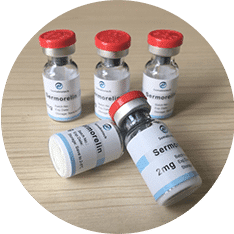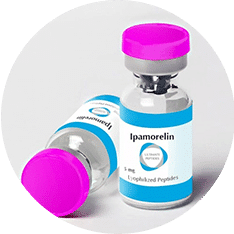
Unlock a More Youthful You With Hormone Replacemment Therapy In Little Ferry, NJ
Aging is inevitable, and for many, it signals the beginning of a new chapter - one where you cross off bucket list items and live life to the fullest, on your own terms. However, for some women, aging is a horrible prospect, filled with chronic fatigue, irritability, and inability to perform in the bedroom. If you're concerned about life in middle age and beyond, we've got great news: there are easy, proven steps that you can take to help stop the negative effect of aging.
Global Life Rejuvenation was founded to give women a new lease on life - one that includes less body fat, fewer mood swings, and more energy as you age. If you're ready to look and feel younger, it's time to consider HRT (hormone replacement therapy), and growth hormone peptides. These therapies for men and women are effective, safe, and customized to fit your goals, so you can keep loving life as you get older.
HRT, and growth hormone peptide therapies bridge the gap between your old life and the more vibrant, happier version of you. With a simple click or call, you can be well on your way to a brighter future. After all, you deserve to be the one in charge of your wellness and health. Now, you have the tools to do so - backed by science and applied by our team of HRT experts with more than 13 years of experience.
What is HRT?
As women age, their hormones begin to go through changes that affect their day-to-day lives. For women, hormone deficiency and imbalance usually occur during menopause and can cause chronic fatigue, hot flashes, and mood swings, among other issues. Hormone replacement therapy helps correct hormone imbalances in women, helping them feel more vibrant and virile as they age.
Often, HRT treatments give patients enhanced quality of life that they didn't think was possible - even in their 60's and beyond.
The benefits for women are numerous and are available today through Global Life Rejuvenation.
HORMONE REPLACEMENT THERAPY
HRT and Anti-Aging Medicine for Women in Little Ferry, NJ
As women age, their bodies begin to go through significant changes that affect their quality of life. This change is called menopause and marks the end of a woman's menstrual cycle and reproduction ability. Though there is no specific age when this change occurs, the average age of menopause onset is 51 years old. However, according to doctors, menopause officially starts 12 months after a woman's final period. During the transition to menopause, women's estrogen and other hormones begin to deplete.
As that happens, many women experience severe symptoms. These symptoms include:
- Hot Flashes
- Chronic Fatigue
- Incontinence
- Trouble Sleeping
- Dryness
- Muscle Loss
- Fat Gain
- Mood Swings
The symptoms of hormone deficiency can be concerning and scary for both women and their spouses. However, if you're getting older and notice some of these symptoms, there is reason to be hopeful. Hormone replacement therapy and anti-aging medicine for women can correct imbalances that happen during menopause. These safe, effective treatments leave you feeling younger, healthier, and more vibrant.


What Causes Menopause?
The most common reason for menopause is the natural decline in a female's reproductive hormones. However, menopause can also result from the following situations:
Oophorectomy: This surgery, which removes a woman's ovaries, causes immediate menopause. Symptoms and signs of menopause in this situation can be severe, as the hormonal changes happen abruptly.
Chemotherapy: Cancer treatments like chemotherapy can induce menopause quickly, causing symptoms to appear shortly after or even during treatment.
Ovarian Insufficiency: Also called premature ovarian failure, this condition is essentially premature menopause. It happens when a woman's ovaries quit functioning before the age of 40 and can stem from genetic factors and disease. Only 1% of women suffer from premature menopause, but HRT can help protect the heart, brain, and bones.
Common Issues for Women During Menopause
For many women, menopause is a trying time that can be filled with many hormonal hurdles to jump through. A little knowledge can go a long way, whether you're going through menopause now or are approaching "that" age.
Here are some of the most common issues that women experience during menopause:

Depression
If you're a woman going through menopause and find that you have become increasingly depressed, you're not alone. It's estimated that 15% of women experience depression to some degree while going through menopause. What many women don't know is that depression can start during perimenopause, or the years leading up to menopause.
Depression can be hard to diagnose, especially during perimenopause and menopause. However, if you notice the following signs, it might be time to speak with a physician:
- Mood Swings
- Inappropriate Guilt
- Chronic Fatigue
- Too Much or Too Little Sleep
- Lack of Interest in Life
- Overwhelming Feelings
Remember, if you're experiencing depression, you're not weak or broken - you're going through a very regular emotional experience. The good news is that with proper treatment from your doctor, depression isn't a death sentence. And with HRT and anti-aging treatment for women, depression could be the catalyst you need to enjoy a new lease on life.

Hot Flashes
Hot flashes - they're one of the most well-known symptoms of menopause. Hot flashes are intense, sudden feelings of heat across a woman's upper body. Some last second, while others last minutes, making them incredibly inconvenient and uncomfortable for most women.
Symptoms of hot flashes include:
- Sudden, Overwhelming Feeling of Heat
- Anxiety
- High Heart Rate
- Headache
- Nausea
- Dizziness
Typically, hot flashes are caused by a lack of estrogen. Low estrogen levels negatively affect a woman's hypothalamus, the part of the brain that controls body temperature and appetite. Low estrogen levels cause the hypothalamus to incorrectly assume the body is too hot, dilating blood vessels to increase blood flow. Luckily, most women don't have to settle for the uncomfortable feelings that hot flashes cause. HRT treatments for women often stabilize hormones, lessening the effects of hot flashes and menopause in general.

Mood Swings
Mood swings are common occurrences for most people - quick shifts from happy to angry and back again, triggered by a specific event. And while many people experience mood swings, they are particularly common for women going through menopause. That's because, during menopause, the female's hormones are often imbalanced. Hormone imbalances and mood swings go hand-in-hand, resulting in frequent mood changes and even symptoms like insomnia.
The rate of production of estrogen, a hormone that fluctuates during menopause, largely determines the rate of production the hormone serotonin, which regulates mood, causing mood swings.
Luckily, HRT and anti-aging treatments in Little Ferry, NJ for women work wonders for mood swings by regulating hormone levels like estrogen. With normal hormone levels, women around the world are now learning that they don't have to settle for mood swings during menopause.

Weight Gain
Staying fit and healthy is hard for anyone living in modern America. However, for women with hormone imbalances during perimenopause or menopause, weight gain is even more serious. Luckily, HRT treatments for women coupled with a physician-led diet can help keep weight in check. But which hormones need to be regulated?
- Estrogen: During menopause, estrogen levels are depleted. As such, the body must search for other sources of estrogen. Because estrogen is stored in fat, your body believes it should increase fat production during menopause. Estrogen also plays a big part in insulin resistance, which can make it even harder to lose weight and keep it off.
- Progesterone: Progesterone levels are also depleted during menopause. Progesterone depletion causes bloating and water retention, while loss of testosterone limits the body's ability to burn calories.
- Ongoing Stress: Stress makes our bodies think that food is hard to come by, putting our bodies in "survival mode". When this happens, cortisol production is altered. When cortisol timing changes, the energy in the bloodstream is diverted toward making fat. With chronic stress, this process repeatedly happens, causing extensive weight gain during menopause.

Low Libido
Lowered sexual desire - three words most men and women hate to hear. Unfortunately, for many women in perimenopausal and menopausal states, it's just a reality of life. Thankfully, today, HRT and anti-aging treatments Little Ferry, NJ can help women maintain a normal, healthy sex drive. But what causes low libido in women, especially as they get older?
The hormones responsible for low libido in women are progesterone, estrogen, and testosterone.
Progesterone production decreases during perimenopause, causing low sex drive in women. Lower progesterone production can also cause chronic fatigue, weight gain, and other symptoms. On the other hand, lower estrogen levels during menopause lead to vaginal dryness and even vaginal atrophy or loss of muscle tension.
Lastly, testosterone plays a role in lowered libido. And while testosterone is often grouped as a male hormone, it contributes to important health and regulatory functionality in women. A woman's testosterone serves to heighten sexual responses and enhances orgasms. When the ovaries are unable to produce sufficient levels of testosterone, it often results in a lowered sex drive.

Vaginal Dryness
Often uncomfortable and even painful, vaginal dryness is a serious problem for sexually active women. However, like hair loss in males, vaginal dryness is very common - almost 50% of women suffer from it during menopause.
Getting older is just a part of life, but that doesn't mean you have to settle for the side effects. HRT and anti-aging treatments for women correct vaginal dryness by re-balancing estrogen, progesterone, and testosterone. When supplemented with diet and healthy living, your vagina's secretions are normalized, causing discomfort to recede.

Fibroids
Uterine fibroids - they're perhaps the least-known symptom of menopause and hormone imbalances in women. That's because these growths on the uterus are often symptom-free. Unfortunately, these growths can be cancerous, presenting a danger for women as they age.
Many women will have fibroids at some point. Because they're symptomless, they're usually found during routine doctor exams. Some women only get one or two, while others may have large clusters of fibroids. Because fibroids are usually caused by hormone imbalances, hysterectomies have been used as a solution, forcing women into early menopause.
Advances in HRT and anti-aging medicine for women give females a safer, non-surgical option without having to experience menopause early. At Global Life Rejuvenation, our expert physicians will implement a customized HRT program to stabilize your hormones and reduce the risk of cancerous fibroid growth.

Endometriosis
Endometriosis symptoms are much like the effects of PMS, and include pelvic pain, fatigue, cramping, and bloating. While doctors aren't entirely sure what causes this painful, uncomfortable condition, most agree that hormones - particularly xenoestrogens - play a factor.
Endometriosis symptoms are much like the effects of PMS and include pelvic pain, fatigue, cramping, and bloating. While doctors aren't entirely sure what causes this painful, uncomfortable condition, most agree that hormones - particularly xenoestrogens - play a factor.
Xenoestrogen is a hormone that is very similar to estrogen. Too much xenoestrogen is thought to stimulate endometrial tissue growth. HRT for women helps balance these hormones and, when used with a custom nutrition program, can provide relief for women across the U.S.
Is HRT for Women the Right Answer?
Hormone stability is imperative for a healthy sex drive and for a normal, stress-free life during menopause. HRT and anti-aging treatments for women balance the hormones that your body has altered due to perimenopause or menopause.
HRT for women is a revolutionary step in helping women live their best lives, even as they grow older. However, at Global Life Rejuvenation, we know that no two patients are the same. That's why we specialize in holistic treatments that utilize HRT, combined with healthy nutrition, supplements, and fitness plans that maximize hormone replacement treatments.
If you've been suffering through menopause, is HRT the answer? That's hard to say without an examination by a trusted physician, but one thing's for sure. When a woman balances her hormone levels, she has a much better shot at living a regular life with limited depression, weight gain, mood swings, and hot flashes.
Here are just a few additional benefits of HRT and anti-aging treatments for females:


Benefits of HRT and Anti-Aging Medicine for Women in Little Ferry, NJ
Hormone imbalance causes a litany of issues. But with anti-aging treatments for women, females can better process calcium, keep their cholesterol levels safe, and maintain a healthy vagina. By replenishing the body's estrogen supply, HRT can relieve symptoms from menopause and protect against osteoporosis. But that's just the start.
Global Life Rejuvenation's patients report many more benefits of HRT and anti-aging medicine for women:
- Fewer Mood Swings
- Thicker Hair
- Stronger Bones
- Less Body Fat
- More Energy
- More Stamina
- Increased Sex Drive and Pleasure Sensations
- Better Cognitive Functions
- Improved Pain Receptors
- Less Hot Flashes and Night Sweats
- Lower Triglycerides
- Fewer Bladder Infections
If you're ready to feel better, look better, and recapture the vitality of your youth, it's time to contact Global Life Rejuvenation. It all starts with an in-depth consultation, where we will determine if HRT and anti-aging treatments for women are right for you. After all, every patient's body and hormone levels are different. Since all our treatment options are personalized, we do not have a single threshold for treatment. Instead, we look at our patient's hormone levels and analyze them on a case-by-case basis.

HRT from Global Life Rejuvenation
At Global Life Rejuvenation, we help women rediscover their youth with HRT treatment for women. We like to think of ourselves as an anti-aging concierge service, guiding and connecting our patients to the most qualified HRT physicians available. With customized HRT treatment plan for women, our patients experience fewer menopausal symptoms, less perimenopause & menopause depression, and often enjoy a more youth-like appearance.
Reverse Aging with Growth Hormone Peptides
Growth hormone peptides are an innovative therapy that boosts the natural human growth hormone production in a person's body. These exciting treatment options help slow down the aging process and give you a chance at restoring your youth.

What is Sermorelin?
Sermorelin is a synthetic hormone peptide, like GHRH, which triggers the release of growth hormones. When used under the care of a qualified physician, Sermorelin can help you lose weight, increase your energy levels, and help you feel much younger.

Benefits of Sermorelin
Human growth hormone (HGH) therapy has been used for years to treat hormone deficiencies. Unlike HGH, which directly replaces declining human growth hormone levels, Sermorelin addresses the underlying cause of decreased HGH, stimulating the pituitary gland naturally. This approach keeps the mechanisms of growth hormone production active.
- Benefits of Sermorelin include:
- Better Immune Function
- Improved Physical Performance
- More Growth Hormone Production
- Less Body Fat
- Build More Lean Muscle
- Better Sleep

What is Ipamorelin?
Ipamorelin helps to release growth hormones in a person's body by mimicking a peptide called ghrelin. Ghrelin is one of three hormones which work together to regulate the growth hormone levels released by the pituitary gland. Because Ipamorelin stimulates the body to produce growth hormone, your body won't stop its natural growth hormone production, which occurs with synthetic HGH.
Ipamorelin causes growth hormone secretion that resembles natural release patterns rather than being constantly elevated from HGH. Because ipamorelin stimulates the natural production of growth hormone, our patients can use this treatment long-term with fewer health risks.

Benefits of Ipamorelin
One of the biggest benefits of Ipamorelin is that it provides significant short and long-term benefits in age management therapies. Ipamorelin can boost a patient's overall health, wellbeing, and outlook on life.
When there is an increased concentration of growth hormone by the pituitary gland, there are positive benefits to the body. Some benefits include:
- Powerful Anti-Aging Properties
- More Muscle Mass
- Less Unsightly Body Fat
- Deep, Restful Sleep
- Increased Athletic Performance
- More Energy
- Less Recovery Time for Training Sessions and Injuries
- Enhanced Overall Wellness and Health
- No Significant Increase in Cortisol
Your New, Youthful Lease on Life with HRT for Women
Whether you are considering our HRT and anti-aging treatments for women in Little Ferry, NJ, we are here to help. The first step to reclaiming your life begins by contacting Global Life Rejuvenation. Our friendly, knowledgeable HRT experts can help answer your questions and walk you through our procedures. From there, we'll figure out which treatments are right for you. Before you know it, you'll be well on your way to looking and feeling better than you have in years!
 866-793-9933
866-793-9933
Request a Consultation
Latest News in Little Ferry, NJ
Several areas in NJ designated by FEMA as ‘disaster resilience zones’
Kimberlee Bongardhttps://www.njspotlightnews.org/2023/09/fema-designates-several-nj-areas-community-disaster-resilience-zones/
Several flood-prone areas in New Jersey have been earmarked by federal officials to receive additional support to protect communities against climate change.The Federal Emergency Management Agency designated 483 census tracts nationwide as Community Disaster Resilience Zones earlier this month.FEMA listed eight zones in New Jersey, including parts of Bergen, Hudson, Atlantic and Cape May counties. The eight zones are in Little Ferry, Moonachie, Kearny, Atlantic City, Pleasantville, Wildwood, North Wildwood and Commercial Townsh...
Several flood-prone areas in New Jersey have been earmarked by federal officials to receive additional support to protect communities against climate change.
The Federal Emergency Management Agency designated 483 census tracts nationwide as Community Disaster Resilience Zones earlier this month.
FEMA listed eight zones in New Jersey, including parts of Bergen, Hudson, Atlantic and Cape May counties. The eight zones are in Little Ferry, Moonachie, Kearny, Atlantic City, Pleasantville, Wildwood, North Wildwood and Commercial Township.
FEMA will use the designated zones to prioritize grant funding and to increase the federal share of the cost of resiliency projects in those areas.
“The priority is to assist communities that are at the highest risk to climate impacts and have the most need for assistance,” Victoria Salinas, FEMA associate administrator for resilience, said during a recent call with reporters.
Risk index
According to FEMA, no new source of funding is tied to the Resilience Zone list. Rather, communities on it will be prioritized for grant funding not just from FEMA but from other federal agencies.
FEMA made the designations after the Community Disaster Resilience Zones Act, signed into law last year, instructed the agency to identify areas at high risk from the impacts of climate change and other natural hazards.
To compile the list, FEMA used its National Risk Index, which rates census tracts based on their vulnerability to different natural hazards, including coastal flooding, hurricanes, wildfires and drought. FEMA also considered socioeconomic factors that can impact a community’s disaster resilience. The agency identified the top 50 census tracts with the highest risk for all natural hazards nationwide, as well as the top 1% for each state.
In Bergen County, the towns of Moonachie and Little Ferry, among the hardest hit by Superstorm Sandy, were identified as Community Disaster Resilience Zones. Extreme flooding remains a threat for towns along the Hackensack River. Coincidentally, the state Department of Environmental Projection last week announced the awarding of a $46.6 million construction contract related to Rebuild by Design Meadowlands, a flood resilience project to protect Little Ferry and neighboring towns from future storms. The funding comes from a federal grant program.
The first phase of construction, which includes installation of a pump station in Little Ferry to reduce storm-surge flooding and improve drainage within the Losen Slote Creek watershed during heavy rain storms, is expected to begin at the end of October.
Need for protection
“We are happy that FEMA is going to give us an opportunity to be able to apply for and receive grants to further strengthen our infrastructure and flood mitigation plans,” said Little Ferry Mayor Mauro Raguseo. “The Rebuild by Design project starting and the designation by FEMA hopefully means that we will have even more funds available to protect our community.”
Most of the Community Disaster Resilience Zones listed for New Jersey are in coastal areas.
‘We are happy that FEMA is going to give us an opportunity to be able to apply for and receive grants to further strengthen our infrastructure and flood mitigation plans.’ — Little Ferry Mayor Mauro Raguseo
Vince Jones, the director of the Office of Emergency Management for Atlantic County, said resiliency efforts are critical in coastal communities like Atlantic City that are seeing increased high-tide flooding in low-lying areas, even on sunny days without rainfall.
The National Oceanic and Atmospheric Administration released its annual high-tide flooding outlook last month, which found the mid-Atlantic region is likely to see nine to 14 high-tide flood days between May 2023 and April 2024, about three times as many as occurred in 2000. Atlantic City could see as many as 15 high-tide flood days during that period, according to NOAA. High-tide flooding happens when tides reach between 1 to 2 feet above the daily average high tide.
“Thankfully they’ve realized our vulnerabilities and they’ve finally identified it,” said Jones. “Especially in these couple areas, where the towns themselves really don’t have the funding to even begin to do some of the projects that they need to try to make themselves resilient.”
Jacques Howard, Atlantic City’s director of planning and development, said he hopes additional funds from FEMA could be used to rebuild deteriorating bulkheads and raise homes in back-bay neighborhoods that are vulnerable to flooding.
“The elevation of these homes oftentimes is $100,000 plus. It’s not cheap,” Howard said. “These funds should be able to facilitate those property owners that in the past may not have been able to raise their homes.”
Funding realities
Jones said municipalities are awaiting more information regarding what grant opportunities will be available to them under the designation.
“We’re hoping that there’s different kinds of fundings that comes out — some for flood protection, maybe some for residential or community-based programs. We’re hoping that when you talk about the money, it’s a lot of different categories that we can avail ourselves [of],” Jones said.
FEMA officials said they hope that nonprofits, philanthropies, businesses and others in the private sector will use the zones to identify where to focus funding or resilience efforts.
More zones will be announced this fall and another round of designations will be made next year based on updates to the National Risk Index. The initial designation as a Community Disaster Resilience Zone lasts five years.
Little Ferry school built in 1914 will be demolished this summer. Here's why
North Jersey Media Grouphttps://www.northjersey.com/story/news/bergen/little-ferry/2023/06/08/little-ferry-nj-school-demolished-summer/70297177007/
3-minute read Megan BurrowNorthJersey.comLITTLE FERRY — Washington School, the 109-year-old elementary school that closed five years ago due to its deteriorating condition, will be demolished this summer to make way for a new school building.Officials plan to ask voters in a referendum sometime next year to fund the construction of a new middle schoo...
3-minute read
NorthJersey.com
LITTLE FERRY — Washington School, the 109-year-old elementary school that closed five years ago due to its deteriorating condition, will be demolished this summer to make way for a new school building.
Officials plan to ask voters in a referendum sometime next year to fund the construction of a new middle school at the Liberty Street site.
“You have to remember this building is over 100 years old,” said Superintendent Frank Scarafile, who is leaving the district next month after 18 years. “We’ve looked at every angle to preserve the building. It’s part of Little Ferry's history. But we really need to look forward at what the community needs.”
Washington School closed in June 2018 after the district spent more than $130,000 on emergency repairs, when officials learned that it would take millions more to fix the aging building.
An architect and engineer were hired to inspect classrooms after part of a ceiling fell in a room the previous December. More compromised ceilings were found, each costing $12,000 to $15,000 to replace.
The school was severely damaged more than a decade ago during Superstorm Sandy, which left the school's gym, five classrooms and a computer lab under 4 feet of water. Nike funded the cost of a new waterproof gym floor, and hundreds of thousands of dollars was spent on repairs to reopen the damaged classrooms, much of it covered by insurance.
But the building’s issues didn’t end there: The roof leaked, its classrooms were flood-prone, the walls hid asbestos and the school did not meet accessibility standards.
At the time, a feasibility study put the cost to rehabilitate the building at more than $9 million. The price would likely be much higher today, officials said.
The brick building’s 13 classrooms are outdated and are unable to meet the district's needs as it grows, said Matthew Perrapato, the incoming superintendent. Plans for a new, larger building include science labs, modern classrooms and a cafeteria with a working kitchen.
“Rehabbing Washington would be expensive, and it also wouldn’t give us what we need when the work is complete,” he said. “We need more classrooms, science labs and common space areas.”
The district will award a bid early next month to a contractor to tear down the building and clear the site. The work will take about four months to complete, officials said.
Since 2018, the district’s first and second graders have been learning in 16 modular classrooms near Memorial School, just across the street from Washington. The classes also house some of the district’s special education programs.
More:Bergen County 2023 primary election results
Generations of borough children have passed through Washington School’s doors since it opened in 1914. Longtime residents have fond memories of their early years spent there: playing games on creaky wooden floors, kindergarten classrooms with fireplaces, and Friday night dances in the gymnasium.
Decades ago, students would line up according to gender outside separate girls' and boys' entrances, marked with embossed stone signs above the doors.
Officials say they want to honor that past while looking toward the future. Residents are invited to share photos and memories at lfboe.org/LittleFerryFuture. The school’s cornerstone will be preserved and used in the construction of the new building, said Victoria Bradley, the Board of Education president.
Earlier plans to ask voters to fund a new K-6 school at the site and eventually turn Memorial School into a junior-senior high school were progressing, “but then COVID hit and knocked everything off the rails,” Scarafile said.
Those plans changed again last year when Little Ferry was awarded a state grant for a free pre-K program. In September, 85 students will attend the program, about half of the borough’s pre-kindergarten-age population.
The district has five years to expand to meet the needs of 90% of eligible 3- and 4-year-olds, according to state requirements.
Current plans call for a new middle school at the Washington School site, and for Memorial School to serve students in pre-K through fifth grade.
“This will be an exciting journey for the entire community,” Bradley said. “It’s an investment in the future.”
A referendum will likely be put to voters next spring. The Hackensack firm RSC Architects is working on the new building’s design. Officials say it is too early to know how much the project will cost.
Earlier plans, also designed by the firm in 2019, for a three-story, 83,000-square-foot building had a price tag of roughly $30 million, with about a third of the cost covered by the state.
Little Ferry pays Ridgefield Park more than $17,000 annually for each of its 275 high school students to attend Ridgefield Park Junior-Senior High School. Officials still hope eventually to bring borough high schoolers back to the district but are taking it one step at a time.
“It’s a process. We need to take care of these buildings first and get the students out of the modulars,” Perrapato said. “These conversations are happening simultaneously, but right now we need to get the elementary and middle school students in their own buildings and then look at next steps.”
Remember Sandy? This Meadowlands project aims to reduce such flooding
Sammy Gibbonshttps://www.northjersey.com/story/news/2023/09/22/meadowlands-hoboken-nj-funds-protect-areas-flooding-sandy/70924390007/
2-minute readNorth Jersey’s flood protection plans took a key step forward last week as the state announced new contracts totaling nearly $298 million to support two major flood-resilience projects, one in the Meadowlands and another in Hoboken and parts of Jersey City and Weehawken.The Meadowlands communities that will benefit include Little Ferry, Carlstadt, Moonachie, South Hackensack and Teterboro.Both projects aim to protect the areas from flooding caused by severe storms and rising sea levels...
2-minute read
North Jersey’s flood protection plans took a key step forward last week as the state announced new contracts totaling nearly $298 million to support two major flood-resilience projects, one in the Meadowlands and another in Hoboken and parts of Jersey City and Weehawken.
The Meadowlands communities that will benefit include Little Ferry, Carlstadt, Moonachie, South Hackensack and Teterboro.
Both projects aim to protect the areas from flooding caused by severe storms and rising sea levels, issues tied to worsening climate change impacts. The contracts were announced by Shawn LaTourette, commissioner of the state Department of Environmental Protection, as part of Climate Week, designed to educate the public about climate change and actions to address its effects.
The Meadowlands project aims to lower the risk of rainfall flooding and to accelerate recovery times from storm surge flooding within the Losen Slote Creek watershed in Little Ferry and surrounding towns, the DEP said.
Response to Superstorm Sandy
Rebuild by Design Meadowlands was created after Superstorm Sandy to reinforce flood resiliency in Little Ferry and nearby towns also hit hard by Sandy in 2012. The storm surge caused the Hackensack River to flood and “took over 70% of the town,” Little Ferry Mayor Mauro Raguseo told NorthJersey.com. Over a decade later, the low-lying and densely populated area remains vulnerable to flooding, especially given the growing impacts of climate change.
The company that was awarded a $45.6 million contract, Union Paving & Construction, will begin construction this fall. It plans to install new infrastructure to improve drainage in the watershed. The team also plans to build a second pump station and make channel improvements.
More:Corps of Engineers picks $52B floodgate plan to protect Meadowlands from Sandy-like storms
Due to old age, the area’s network of drainage channels and ditches does not provide adequate drainage after heavy rains, a project fact sheet says. Construction crews will deepen and widen the East Riser Ditch, remove sediment and debris, and add native plants to the embankment to enhance biodiversity.
Union will also replace the railroad bridge over the East Riser Ditch in Carlstadt, which is one portion of the project among others that may temporarily affect traffic in the area.
More:A decade after Sandy, devastated Meadowlands towns still adding defenses, still vulnerable
“When completed, this project will have a measurable impact in preventing flooding in a large area of our community that has been prone to rising water in heavy rainstorms,” Raguseo said. “Like any major infrastructure construction project there may be detours and disturbances for a period of time, but it will certainly be worth it in the end when we see the final result.”
With enough funds, the Meadowlands project may also include a new park and green infrastructure designed for municipally owned buildings in the area, the project’s webpage says.
Hoboken project along the Hudson
The Hoboken project along the Hudson River will involve building more than 9,000 linear feet of resistance structures to serve as barriers during high tides and storm surges. The $251 million contract will also cover installation of a comprehensive stormwater drainage system.
The financial push moves these projects along after a nine-year planning process that involved extensive community engagement. The DEP and project teams are working with local officials to ensure that their work causes minimal traffic and quality-of-life disruptions, the DEP said.
The public can learn more about the projects and sign up to receive updates about topics like construction and related meetings on the Department of Environmental Protection’s Rebuild by Design webpage.
Capodagli Property Company Secures $71M to Complete 110 Bergen Turnpike in Little Ferry, New Jersey
Sebastian Morrishttps://newyorkyimby.com/2021/11/%E2%80%8B%E2%80%8B%E2%80%8B%E2%80%8B%E2%80%8Bcapodagli-property-company-secures-71m-to-complete-110-bergen-turnpike-in-little-ferry-new-jersey.html
Capodagli Property Company recently secured $71 million in construction financing to complete a new residential property at 110 Bergen Turnpike in Little Ferry, New Jersey. When complete, the property will comprise 294 apartments spread across two buildings.Renderings of the property appear to reveal a ground-floor retail component with the residential volume positioned above. The façade will comprise alternating white metal cladding and ...
Capodagli Property Company recently secured $71 million in construction financing to complete a new residential property at 110 Bergen Turnpike in Little Ferry, New Jersey. When complete, the property will comprise 294 apartments spread across two buildings.
Renderings of the property appear to reveal a ground-floor retail component with the residential volume positioned above. The façade will comprise alternating white metal cladding and tan paneling. The developer has not confirmed the property’s residential amenity package.
SCALE Lending, a Slate Property Group affiliate, provided the financing package. This loan marks the latest closing for SCALE Lending, one of the most active lenders in the New York metropolitan market for construction financing, with more than $1 billion lent over the last 18 months.
The transaction was arranged by Greystone Capital Advisors.
“Deals like 110 Bergen Turnpike demonstrate SCALE’s ability to adapt quickly to expanding markets as we continue our strong growth throughout the New York Metropolitan area,” said Martin Nussbaum, co-founder and principal of Slate Property Group. “This deal is the latest in a series of promising opportunities as we build upon our presence in new and exciting markets. We are proud of our relationships with prominent developers who are looking to expand their footprint and know SCALE is able to help them achieve their goals.”
Subscribe to YIMBY’s daily e-mail
Follow YIMBYgram for real-time photo updates Like YIMBY on Facebook Follow YIMBY’s Twitter for the latest in YIMBYnews
Work is nearing completion on 30 West 39th Street, 27-story hotel tower in Midtown, Manhattan. Designed by Peter Poon Architects and developed by Fortuna Realty, the 323-foot-tall structure will yield 133,500 square feet and 330 rooms. Leeding Builders Group, LLC is the general contractor for the property, which is located between Fifth and Sixth Avenues, a block south of Bryant Park.
Since our last update in February, work has wrapped up on the upper portion of the tower and shifted to the podium, which is in the process of receiving its final cladding behind scaffolding and netting.
The gaps between the perimeter columns in the podium have been enclosed with mechanical ventilation grilles and the concrete walls are lined with a yellow waterproof membrane. This part of the edifice was still exposed back in our last update. At the very top of the building are gray panels going up to the flat roof parapet and a row of six large square windows on the main northern elevation. These appear less transparent than the floor-to-ceiling glass curtain wall that makes up the majority of the façade below.
The blank eastern and western sides of the structure are also fully enclosed in their final gray surface. The sidewalk scaffolding is still up, though we can expect this to be dismantled in the coming months with the envelope above now largely completed.
30 West 39th Street. Photo by Michael Young
Few details about the interior have been announced, though YIMBY last reported that guest amenities will include a ground-floor restaurant, a lounge, a fitness center, and a business center. The nearest subways are the B, D, F, M and 7 trains at the 42 St-Bryant Park station to the north along Sixth Avenue. This station now has a new below-grade walking tunnel for a free transfer to the Shuttle from 6:00 PM to 11:59 PM, and further subterranean access to the 1, 2, 3, N, Q, R, and W trains at the Times Square-42 St station. The A, C, E, and buses at the 42 St-Port Authority Bus Terminal station is also nearby on Eighth Avenue.
A revised completion and opening date is also unclear, though it’s conceivable to see the property up and running sometime in the first half of 2022.
Subscribe to YIMBY’s daily e-mail
Follow YIMBYgram for real-time photo updates Like YIMBY on Facebook Follow YIMBY’s Twitter for the latest in YIMBYnews
Little Ferry's proposal for new school may get September vote
Megan Burrowhttps://www.northjersey.com/story/news/bergen/little-ferry/2019/03/21/little-ferrys-nj-new-elementary-school-could-get-september-vote/3222972002/
LITTLE FERRY — Borough education officials are preparing to ask voters to support building a new elementary school to replace Washington School, which closed last year due to its deteriorating condition.The proposed new school is part of a larger plan to turn Memorial School — an elementary school directly...
LITTLE FERRY — Borough education officials are preparing to ask voters to support building a new elementary school to replace Washington School, which closed last year due to its deteriorating condition.
The proposed new school is part of a larger plan to turn Memorial School — an elementary school directly across the street — into a junior-senior high school. Little Ferry high school students attend Ridgefield Park Junior-Senior High School, at a cost of about $5.5 million a year to the Little Ferry district.
“It is really time to look at this building and not let it sit,” Frank Scarafile, the schools superintendent, said at a borough Planning Board meeting Wednesday night. "If we’re going to move toward a high school, this is the time."
The three-story, 83,000-square-foot building, designed by the Hackensack firm RSC Architects, would have 38 classrooms, a library, a cafeteria and a gymnasium for the district’s pre-K through sixth-grade students.
The school, which would be built above the flood plain at the site of Washington School on Liberty Street, would cost an estimated $30 million, said Ken Mihalik, an architect with the firm. A courtyard for outdoor play would sit in the center of the U-shaped building.
About 30 percent of the cost could be covered by the state, Scarafile said.
The referendum would likely be held in late September, one of four times during the year such a vote can take place.
Before the vote, Scarafile said he plans to hold a series of community meetings to explain the plan to residents and address concerns.
Washington School closed in June after the district spent more than $130,000 on emergency repairs to the 105-year-old building.
The repairs were necessary after a plaster ceiling in a classroom collapsed and an inspection revealed that ceilings in several other classrooms also needed replacement.
The school's problems go beyond the deteriorating ceilings, officials said. The roof of the school leaks, classrooms flood, asbestos lies behind the walls and the electrical system needs an upgrade.
Since September, the district's third- and fourth-graders have been attending school in 16 modular classrooms next to Memorial School. Those classrooms could eventually be used by special education students who are currently sent to schools out of the district, Scarafile said.
Little Ferry:Kimchi Smoke to open new location in H Mart in Little Ferry
Referendum:Glen Rock approves $14.7 million school proposal
Development:The Record's former headquarters in Hackensack to become luxury apartments, retail
The cost to rehabilitate Washington School would be about $9.3 million, according to a feasibility study the district conducted after it closed.
State officials will examine the study and compare the cost with the new school’s price tag when determining whether Little Ferry can move forward with the referendum.
Once that decision is made, the state Department of Education will study the district’s request to bring its high school students back to Little Ferry.
“We’re not looking to take anything from Ridgefield Park, but we want the opportunity to educate our own kids,” Scarafile said. “We’re sending $5.5 million and we have no say on how that is spent.”
This year, the per-pupil cost to send a student to the regional high school is $14,300, up from $13,200 last year.
“If we don’t start thinking about the future here, we’re going to be indebted to Ridgefield Park, it’s going to affect the education of our kids here and we won’t be able to afford to do what we want to do,” Scarafile said.
The district will wait to get an answer from the state on withdrawing its students from Ridgefield Park before moving forward with construction.
If that plan gains approval, the elementary students at Memorial School and in the modular classrooms would move into the new building. Memorial would be renovated for use as a junior-senior high school.
If the state nixes the plan, the proposed building’s design would be scaled back, Scarafile said.
Email: [email protected]
Disclaimer:


